Which Plants Like Banana Peels? Boost Your Garden’s Growth
Banana peels are more than just waste; they are packed with nutrients that can benefit many plants in your garden. By using banana peels as a natural fertilizer, you can give your plants a boost of potassium and other essential nutrients. Plants that thrive with banana peels include tomatoes, roses, peppers, and staghorn ferns.
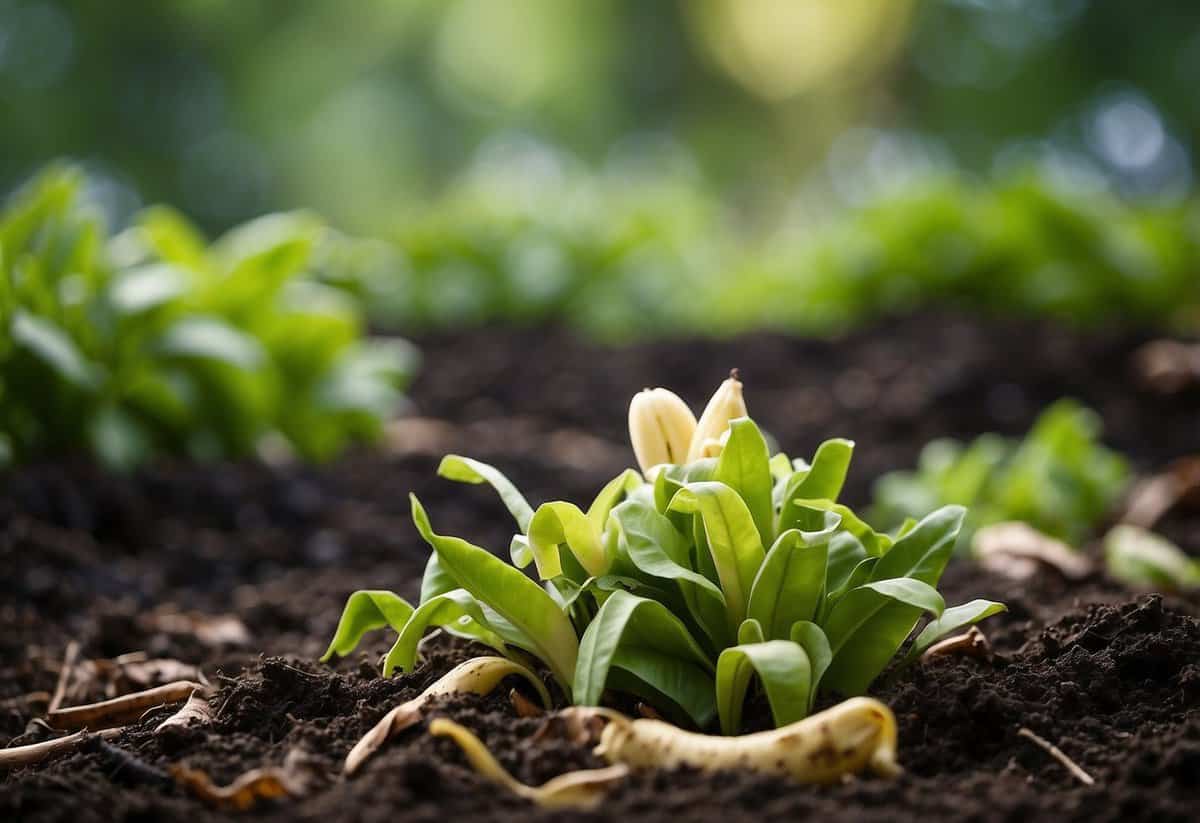
Using banana peels is simple and organic, making it an easy addition to your gardening routine. Banana trees and houseplants can also benefit, growing healthier and stronger. Simply by adding banana peels to your compost or directly into the soil, you can help your plants reach their full potential.
Whether you’re growing flowers or fruits, incorporating banana peels can make a big difference. Even corn, a common garden plant, can benefit from the nutrients found in banana peels. You can find more details on plants that enjoy banana peels and how to use them effectively by checking out this guide.
Benefits of Banana Peels in Gardening

Banana peels can be great for your garden by providing essential nutrients, improving soil health, and keeping pests at bay. They serve as a natural fertilizer and pest repellent, making them a valuable addition to your gardening routine.
Rich Source of Nutrients
Banana peels are packed with essential nutrients that your plants need to thrive.
Potassium is the most notable nutrient in banana peels, helping your plants with water uptake and flowering. For example, tomatoes and roses can benefit greatly from the potassium in banana peels. Additionally, phosphorus in the peels aids in root development, which is critical for any growing plant.
Besides potassium and phosphorus, banana peels also contain calcium, magnesium, nitrogen, and small amounts of sulfur and manganese. These nutrients contribute to the health of your plants, aiding in various aspects like strong stems and healthy leaves. Using banana peels as fertilizer can enrich the soil and provide a steady supply of these key nutrients.
Improving Soil Health
Incorporating banana peels into your garden can significantly improve soil health.
As banana peels decompose, they add organic matter and enhance the compost content in the soil. This organic matter improves soil structure, making it better at retaining moisture and nutrients. For better use, you can bury banana peels near plant roots or mix them into the compost pile.
The NPK (Nitrogen, Phosphorus, Potassium) value of banana peels, although low, can enrich the soil over time. Fresh banana peels have an NPK value of approximately 0.1-0.1-2.3, providing a slow, steady release of these nutrients. This helps maintain soil fertility and reduces the need for chemical fertilizers.
Natural Pest Deterrent
Banana peels can also serve as an organic and natural pest repellent in your garden.
They are effective against pests like aphids, fruit flies, and gnats. One common method is to place small pieces of banana peel around the base of your plants. The scent can deter pests from settling on your plants. Some gardeners blend banana peels with water to create a natural spray that can be applied to the leaves and stems, further protecting your plants from pests.
By preventing pest infestations naturally, banana peels help you maintain a healthier and more productive garden.
How to Use Banana Peels for Plant Care
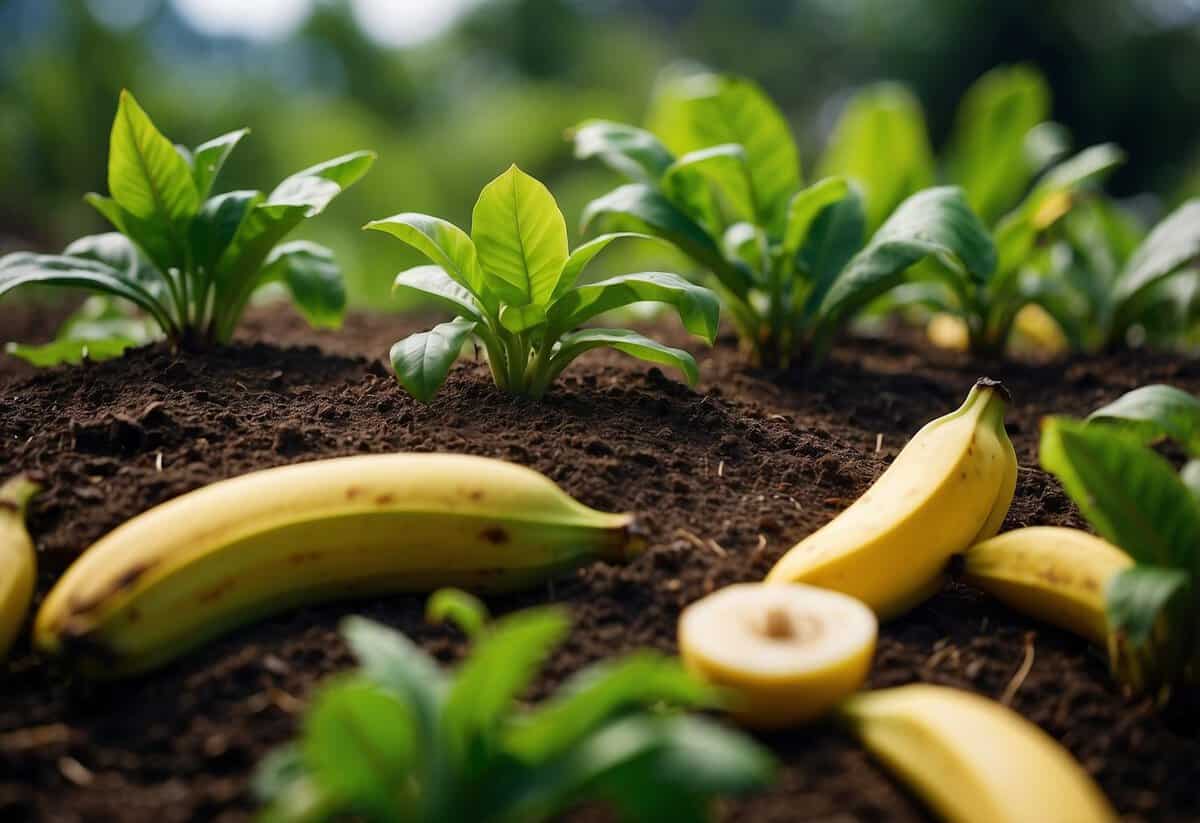
Using banana peels can provide essential nutrients like potassium and vitamins to your plants. Here are two effective methods to make the most out of banana peels.
Making Banana Peel Tea
Banana peel tea is a liquid fertilizer that helps plants grow strong and healthy. To make it, start by soaking banana peels in water. Place several peels in a container filled with about a liter of water. Let them sit for at least 48 hours.
After the soaking period, strain out the peels and keep the water as your tea. Use this liquid to water your plants directly. The nutrients, especially potassium, will transfer to the soil and be absorbed by the plants. This method is ideal for flowering plants, tomatoes, and peppers.
Creating Banana Peel Fertilizer
Another method is to use banana peels directly in your compost pile. Start by drying the peels until they are brittle. You can dry them by leaving them in the sun or using an oven on a low setting. Once dried, crush them into a fine powder.
Mix this powder into your soil or add it to your compost pile. The nutrients from the banana peels will enrich the compost, making it a powerful homemade fertilizer. This is especially beneficial for roses, staghorn ferns, and even banana trees. Using this method ensures that your plants get a slow and steady supply of nutrients.
Best Plants to Use Banana Peels With
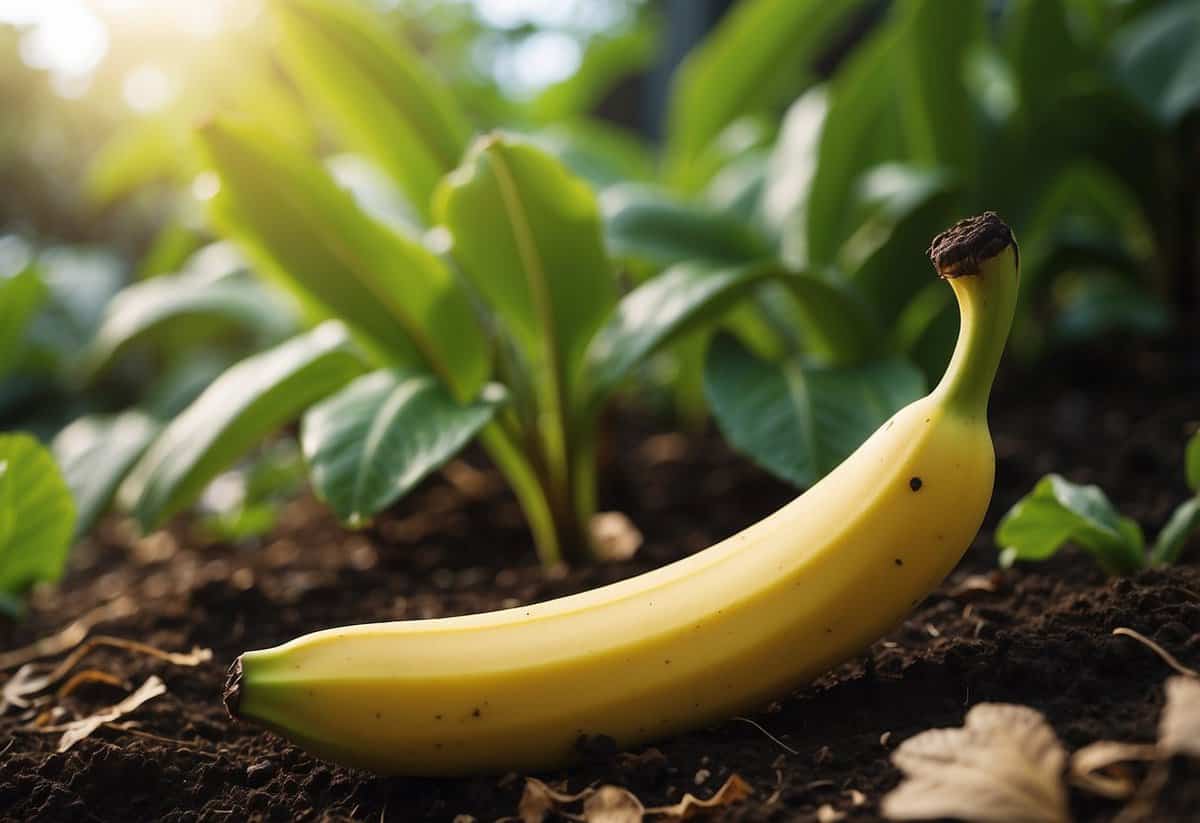
Banana peels are packed with potassium, making them excellent for promoting plant growth, vibrant blooms, and fruit production. They can benefit various types of plants, from fruiting plants to your garden bushes.
Fruiting and Flowering Plants
Tomatoes and Peppers: Banana peels are great for tomatoes and peppers. The potassium in the peels helps these plants grow strong and produce abundant, flavorful fruits. This also helps prevent issues like blossom end rot. You can mix banana peel water or pieces directly into the soil around these plants.
Roses: Roses love potassium. Using banana peels can lead to more vibrant blooms and healthy foliage. You can bury chopped banana peels near the base of your roses to slowly release nutrients over time. This helps roses grow stronger and produce more flowers.
Flowering Plants: Many flowering plants, like staghorn ferns and air plants, can benefit from the nutrients in banana peels. Whether in a garden or home setting, these plants will show stronger growth and more abundant blooms. Simply add pieces of banana peel to the soil or use banana peel compost.
General Garden Plants and Bushes
Banana Trees: It might seem like a no-brainer, but banana trees also benefit from their own peels. They provide a natural way to boost potassium levels, supporting robust growth and better fruit production. Just bury the peels around the base of the tree.
Corn: Corn plants thrive with the added nutrients from banana peels. You can use them to ensure your corn has the potassium it needs to grow tall and produce sweet, flavorful ears. Mix banana peel water into the soil or use chopped peels as a mulch.
Bushes and Other Garden Plants: General garden plants, including bushes, also benefit from banana peels. They can lead to healthier foliage and more vibrant flowers. Burying peels near the roots or adding them to compost can be an effective way to use them.
Indoor Plants and Banana Peel Uses
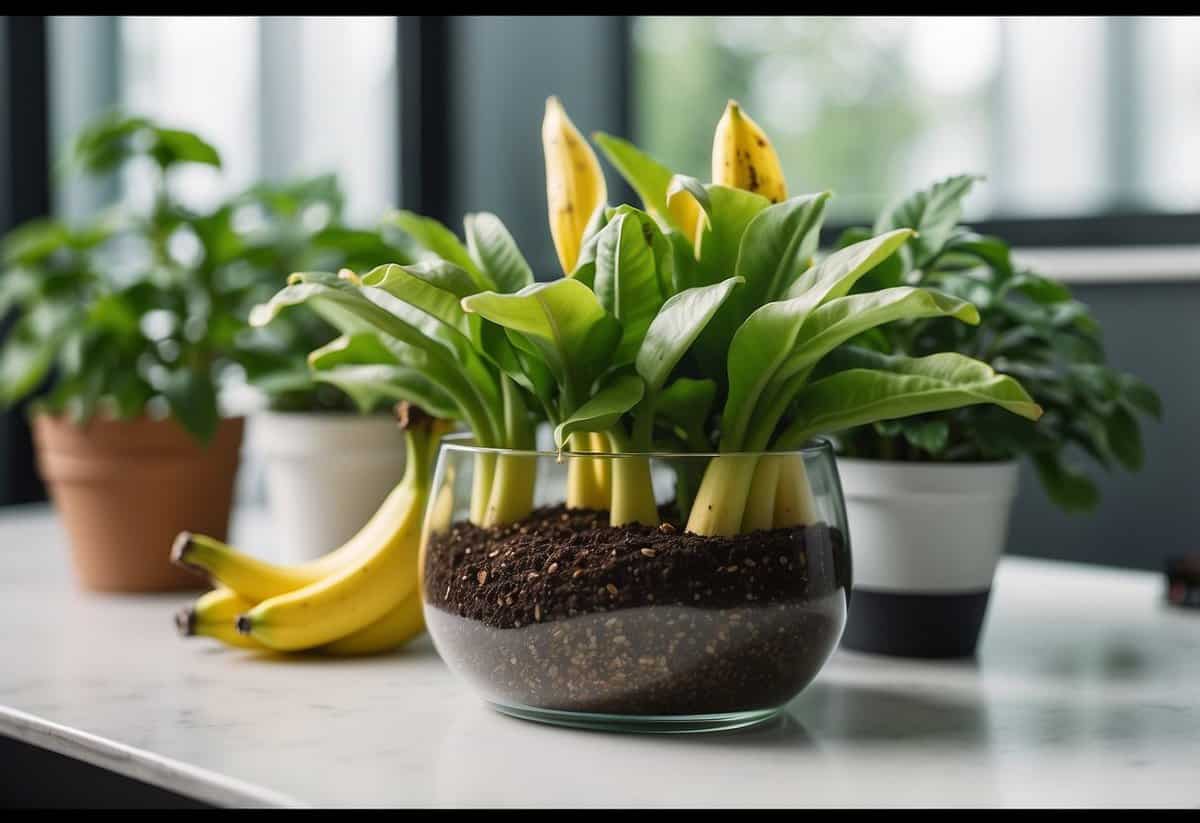
Banana peels can enhance the health of your indoor plants by providing essential nutrients like potassium. Different methods work best for various plants, so knowing how to use banana peels can be beneficial.
Feeding Household Greenery
Banana peels contain high levels of potassium, making them excellent for indoor plants such as houseplants and foliage. To use banana peels, you can place small pieces directly into the soil. As they decompose, they release nutrients that roots absorb, enhancing plant health.
You can also create a banana peel tea. Soak the peels in water for a few days, then use the liquid to water your plants. This method ensures a steady nutrient supply.
If you prefer a hands-off approach, simply bury banana peels under the soil of potted plants. This method works well for air plants that don’t require frequent watering.
Special Cases: Orchids and Ferns
Orchids and ferns, including staghorn ferns, have unique requirements. Orchids, especially, benefit from the slow release of nutrients provided by banana peels. You can mash the peel and apply it thinly to the soil surface.
For staghorn ferns and other ferns, using banana peel tea is more effective. Dip the banana peel in water and let it release nutrients before watering your ferns with the solution.
Air plants, also known as epiphytes, can benefit from a light spray of diluted banana peel tea. These plants absorb nutrients through their leaves, so a thin mist enhances their growth without overwatering.
By tailoring your approach, you can ensure your indoor plants thrive with the help of banana peels.
Creative Ways to Recycle Banana Peels in the Garden
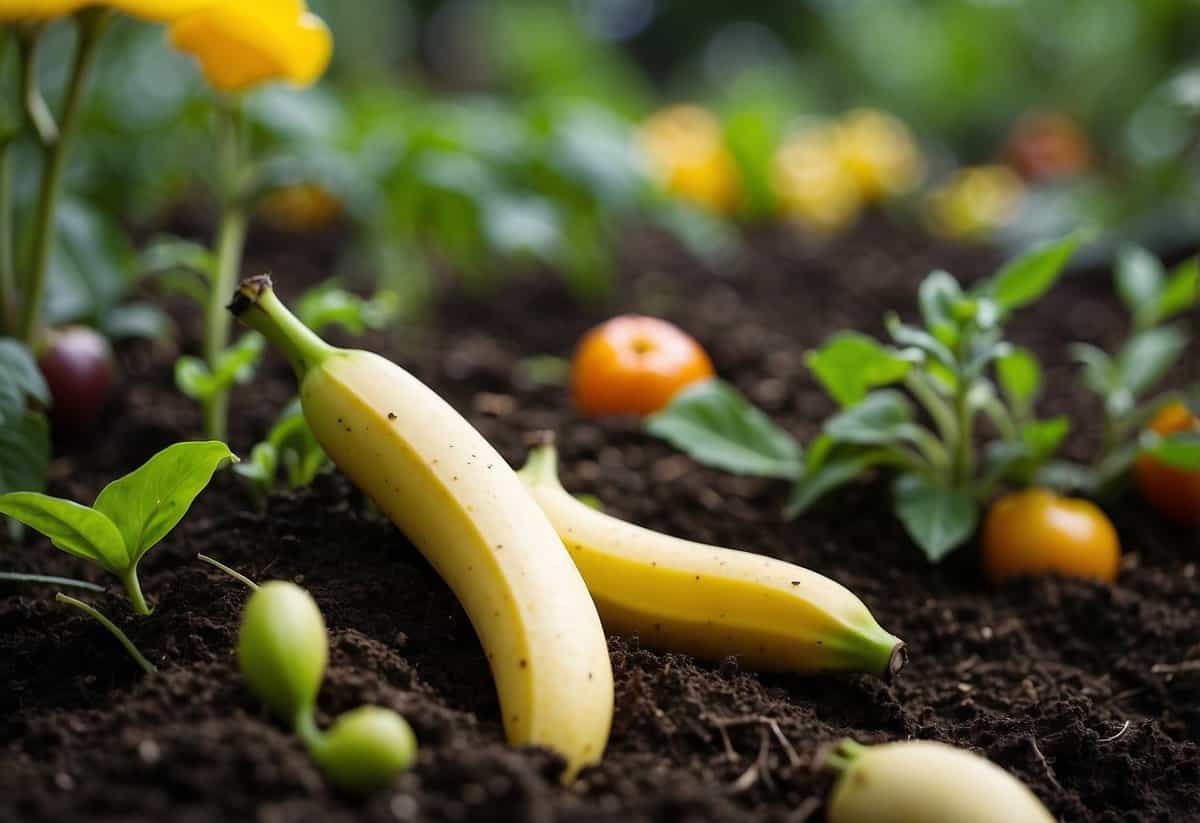
Banana peels are a fantastic natural fertilizer that can help your garden thrive. They provide essential nutrients to acid-loving plants and can be used in several unique ways.
Integrating Banana Peels into Compost
Composting banana peels is a straightforward method to enrich your garden soil. Because banana peels are rich in potassium, they support strong root development and flowering in plants like pumpkins, potatoes, and grapes.
To compost banana peels, chop them into small pieces to speed up decomposition. Add them to your compost heap along with other organic materials. Ensure the compost pile remains moist but not waterlogged, as this balance is crucial for efficient composting.
If you have a wormery, banana peels are an excellent food source for the worms. The worms break down the peels, creating nutrient-rich worm castings that enhance the soil quality. Regularly turning the compost heap helps in quicker breakdown and integration of these natural fertilizers.
Surrounding and Protecting Seedlings
Banana peels can also be used directly in the garden to support seedlings. Lay the peels flat in the soil, then place your seeds or seedlings on top. As the seeds sprout and begin to develop roots, the peels will decompose and provide a continuous supply of nutrients.
This method works wonders for fruiting crops like strawberries and tomatoes. By placing the peels around the base of these plants, you’ll give them a natural, slow-release fertilizer. This not only nourishes the plants but also helps to retain soil moisture.
In addition, banana peels can deter pests. Placing small pieces around seedlings can protect them from unwanted insects while enriching the soil with organic nutrients.
Use these creative ways to recycle banana peels and watch your garden flourish with healthier, more productive plants.







